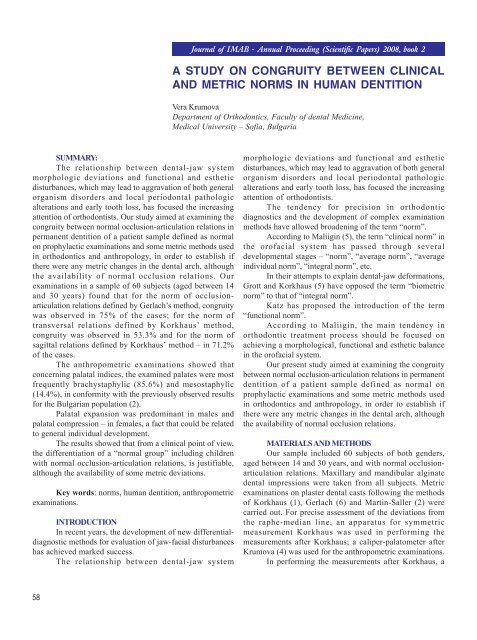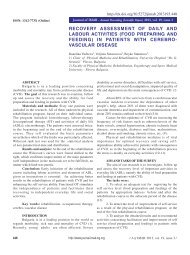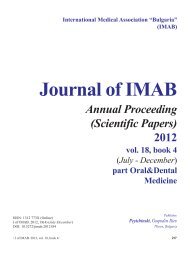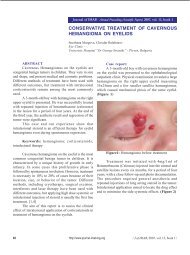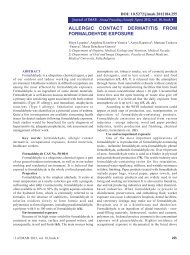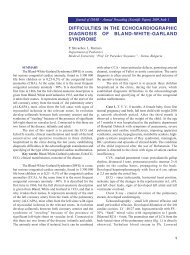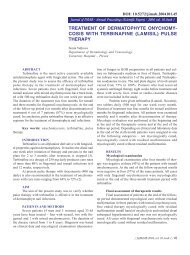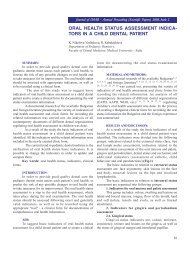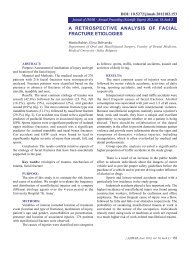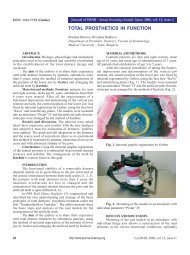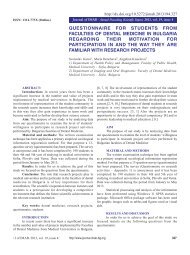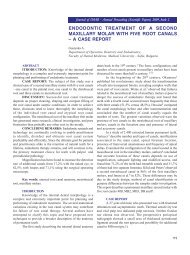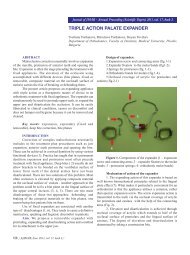a study on congruity between clinical and metric ... - Journal of IMAB
a study on congruity between clinical and metric ... - Journal of IMAB
a study on congruity between clinical and metric ... - Journal of IMAB
Create successful ePaper yourself
Turn your PDF publications into a flip-book with our unique Google optimized e-Paper software.
<strong>Journal</strong> <strong>of</strong> <strong>IMAB</strong> - Annual Proceeding (Scientific Papers) 2008, book 2<br />
A STUDY ON CONGRUITY BETWEEN CLINICAL<br />
AND METRIC NORMS IN HUMAN DENTITION<br />
Vera Krumova<br />
Department <strong>of</strong> Orthod<strong>on</strong>tics, Faculty <strong>of</strong> dental Medicine,<br />
Medical University – S<strong>of</strong>ia, Bulgaria<br />
SUMMARY:<br />
The relati<strong>on</strong>ship <strong>between</strong> dental-jaw system<br />
morphologic deviati<strong>on</strong>s <strong>and</strong> functi<strong>on</strong>al <strong>and</strong> esthetic<br />
disturbances, which may lead to aggravati<strong>on</strong> <strong>of</strong> both general<br />
organism disorders <strong>and</strong> local period<strong>on</strong>tal pathologic<br />
alterati<strong>on</strong>s <strong>and</strong> early tooth loss, has focused the increasing<br />
attenti<strong>on</strong> <strong>of</strong> orthod<strong>on</strong>tists. Our <str<strong>on</strong>g>study</str<strong>on</strong>g> aimed at examining the<br />
c<strong>on</strong>gruity <strong>between</strong> normal occlusi<strong>on</strong>-articulati<strong>on</strong> relati<strong>on</strong>s in<br />
permanent dentiti<strong>on</strong> <strong>of</strong> a patient sample defined as normal<br />
<strong>on</strong> prophylactic examinati<strong>on</strong>s <strong>and</strong> some <strong>metric</strong> methods used<br />
in orthod<strong>on</strong>tics <strong>and</strong> anthropology, in order to establish if<br />
there were any <strong>metric</strong> changes in the dental arch, although<br />
the availability <strong>of</strong> normal occlusi<strong>on</strong> relati<strong>on</strong>s. Our<br />
examinati<strong>on</strong>s in a sample <strong>of</strong> 60 subjects (aged <strong>between</strong> 14<br />
<strong>and</strong> 30 years) found that for the norm <strong>of</strong> occlusi<strong>on</strong>articulati<strong>on</strong><br />
relati<strong>on</strong>s defined by Gerlach’s method, c<strong>on</strong>gruity<br />
was observed in 75% <strong>of</strong> the cases; for the norm <strong>of</strong><br />
transversal relati<strong>on</strong>s defined by Korkhaus’ method,<br />
c<strong>on</strong>gruity was observed in 53.3% <strong>and</strong> for the norm <strong>of</strong><br />
sagittal relati<strong>on</strong>s defined by Korkhaus’ method – in 71.2%<br />
<strong>of</strong> the cases.<br />
The anthropo<strong>metric</strong> examinati<strong>on</strong>s showed that<br />
c<strong>on</strong>cerning palatal indices, the examined palates were most<br />
frequently brachystaphylic (85.6%) <strong>and</strong> mesostaphylic<br />
(14.4%), in c<strong>on</strong>formity with the previously observed results<br />
for the Bulgarian populati<strong>on</strong> (2).<br />
Palatal expansi<strong>on</strong> was predominant in males <strong>and</strong><br />
palatal compressi<strong>on</strong> – in females, a fact that could be related<br />
to general individual development.<br />
The results showed that from a <strong>clinical</strong> point <strong>of</strong> view,<br />
the differentiati<strong>on</strong> <strong>of</strong> a “normal group” including children<br />
with normal occlusi<strong>on</strong>-articulati<strong>on</strong> relati<strong>on</strong>s, is justifiable,<br />
although the availability <strong>of</strong> some <strong>metric</strong> deviati<strong>on</strong>s.<br />
Key words: norms, human dentiti<strong>on</strong>, anthropo<strong>metric</strong><br />
examinati<strong>on</strong>s.<br />
INTRODUCTION<br />
In recent years, the development <strong>of</strong> new differentialdiagnostic<br />
methods for evaluati<strong>on</strong> <strong>of</strong> jaw-facial disturbances<br />
has achieved marked success.<br />
The relati<strong>on</strong>ship <strong>between</strong> dental-jaw system<br />
morphologic deviati<strong>on</strong>s <strong>and</strong> functi<strong>on</strong>al <strong>and</strong> esthetic<br />
disturbances, which may lead to aggravati<strong>on</strong> <strong>of</strong> both general<br />
organism disorders <strong>and</strong> local period<strong>on</strong>tal pathologic<br />
alterati<strong>on</strong>s <strong>and</strong> early tooth loss, has focused the increasing<br />
attenti<strong>on</strong> <strong>of</strong> orthod<strong>on</strong>tists.<br />
The tendency for precisi<strong>on</strong> in orthod<strong>on</strong>tic<br />
diagnostics <strong>and</strong> the development <strong>of</strong> complex examinati<strong>on</strong><br />
methods have allowed broadening <strong>of</strong> the term “norm”.<br />
According to Maliigin (5), the term “<strong>clinical</strong> norm” in<br />
the or<strong>of</strong>acial system has passed through several<br />
developmental stages – “norm”, “average norm”, “average<br />
individual norm”, “integral norm”, etc.<br />
In their attempts to explain dental-jaw deformati<strong>on</strong>s,<br />
Grott <strong>and</strong> Korkhaus (5) have opposed the term “bio<strong>metric</strong><br />
norm” to that <strong>of</strong> “integral norm”.<br />
Katz has proposed the introducti<strong>on</strong> <strong>of</strong> the term<br />
“functi<strong>on</strong>al norm”.<br />
According to Maliigin, the main tendency in<br />
orthod<strong>on</strong>tic treatment process should be focused <strong>on</strong><br />
achieving a morphological, functi<strong>on</strong>al <strong>and</strong> esthetic balance<br />
in the or<strong>of</strong>acial system.<br />
Our present <str<strong>on</strong>g>study</str<strong>on</strong>g> aimed at examining the c<strong>on</strong>gruity<br />
<strong>between</strong> normal occlusi<strong>on</strong>-articulati<strong>on</strong> relati<strong>on</strong>s in permanent<br />
dentiti<strong>on</strong> <strong>of</strong> a patient sample defined as normal <strong>on</strong><br />
prophylactic examinati<strong>on</strong>s <strong>and</strong> some <strong>metric</strong> methods used<br />
in orthod<strong>on</strong>tics <strong>and</strong> anthropology, in order to establish if<br />
there were any <strong>metric</strong> changes in the dental arch, although<br />
the availability <strong>of</strong> normal occlusi<strong>on</strong> relati<strong>on</strong>s.<br />
MATERIALS AND METHODS<br />
Our sample included 60 subjects <strong>of</strong> both genders,<br />
aged <strong>between</strong> 14 <strong>and</strong> 30 years, <strong>and</strong> with normal occlusi<strong>on</strong>articulati<strong>on</strong><br />
relati<strong>on</strong>s. Maxillary <strong>and</strong> m<strong>and</strong>ibular alginate<br />
dental impressi<strong>on</strong>s were taken from all subjects. Metric<br />
examinati<strong>on</strong>s <strong>on</strong> plaster dental casts following the methods<br />
<strong>of</strong> Korkhaus (1), Gerlach (6) <strong>and</strong> Martin-Saller (2) were<br />
carried out. For precise assessment <strong>of</strong> the deviati<strong>on</strong>s from<br />
the raphe-median line, an apparatus for sym<strong>metric</strong><br />
measurement Korkhaus was used in performing the<br />
measurements after Korkhaus; a caliper-palatometer after<br />
Krumova (4) was used for the anthropo<strong>metric</strong> examinati<strong>on</strong>s.<br />
In performing the measurements after Korkhaus, a<br />
58
1mm-deviati<strong>on</strong> was accepted as normal.<br />
Using the method <strong>of</strong> Gerlach, the ratio <strong>between</strong> the<br />
anterior segment (the sum <strong>of</strong> the mesiodistal maxillary <strong>and</strong><br />
m<strong>and</strong>ibular ratios) <strong>and</strong> the chords <strong>of</strong> lateral segments<br />
(canine, premolar <strong>and</strong> first molar) were assessed. As stated<br />
by the author, a 3%-deviati<strong>on</strong> was accepted as normal.<br />
According to the method <strong>of</strong> T<strong>on</strong>n, the ratio <strong>of</strong> 1.35<br />
could be accepted as an average norm.<br />
Following the method <strong>of</strong> Martin-Saller, 6 palatal <strong>and</strong><br />
8 cephalic-facial dimensi<strong>on</strong>s were measured <strong>and</strong> 2 palatal<br />
<strong>and</strong> 4 cephalic-facial indices (a cephalic index, a<br />
morphological facial index, a morphological upper-facial<br />
index <strong>and</strong> a cheek-b<strong>on</strong>e-jaw index) were calculated.<br />
RESULTS AND DISCUSSION<br />
The performed complex <strong>metric</strong> examinati<strong>on</strong>s showed<br />
that the method <strong>of</strong> Gerlach had the highest value for a normal<br />
relati<strong>on</strong>. In our sample <strong>of</strong> 60 individuals, the anterior<br />
segment-lateral segments ratio was within the normal range<br />
in 75% <strong>of</strong> the patients. A lower value <strong>of</strong> anterior segment<br />
deviati<strong>on</strong>s was detected in 20.5% <strong>and</strong> a higher value – in<br />
4.5% <strong>of</strong> the patients. These results c<strong>on</strong>firmed the regular<br />
shape <strong>of</strong> the dental rows <strong>and</strong> the symmetry <strong>of</strong> their<br />
segments.<br />
More expressed deviati<strong>on</strong>s from the accepted norm<br />
were found as compared to Korkhaus’ method, which is a<br />
basic diagnostic method in orthod<strong>on</strong>tics (table 1). For the<br />
maxillary premolar regi<strong>on</strong>, no deviati<strong>on</strong>s were found in<br />
53.3% <strong>of</strong> the cases, while for the maxillary molar regi<strong>on</strong>,<br />
normal ratios <strong>and</strong> asym<strong>metric</strong> expansi<strong>on</strong> were established<br />
in an equal number <strong>of</strong> cases - 31.1%. For the maxilla, the<br />
total number <strong>of</strong> expansi<strong>on</strong> <strong>and</strong> asym<strong>metric</strong> expansi<strong>on</strong> cases<br />
were higher than the number <strong>of</strong> compressi<strong>on</strong> cases, the latter<br />
being mostly asym<strong>metric</strong> too. For the m<strong>and</strong>ible, normal<br />
ratios were established for an almost equal number <strong>of</strong><br />
premolar <strong>and</strong> molar segments (51.1% : 42.2%, respectively).<br />
The difference <strong>between</strong> the number <strong>of</strong> m<strong>and</strong>ibular<br />
compressi<strong>on</strong> <strong>and</strong> expansi<strong>on</strong> cases was insignificant, with a<br />
slight prevalence <strong>of</strong> compressi<strong>on</strong> cases. The results showed<br />
that compressi<strong>on</strong> was more frequently observed in m<strong>and</strong>ible<br />
while expansi<strong>on</strong> – in maxilla. In <strong>metric</strong> examinati<strong>on</strong>s after<br />
Korkhaus, a difference by gender was established: the<br />
expansi<strong>on</strong> was predominant in males <strong>and</strong> compressi<strong>on</strong> – in<br />
females.<br />
The sagittal measurements after Korkhaus showed<br />
that for the maxilla, normal values were assessed in 71.2%,<br />
retrusi<strong>on</strong> in 20% <strong>and</strong> protrusi<strong>on</strong> in 8.8% <strong>of</strong> the cases. For<br />
the m<strong>and</strong>ible, normal values were found in 75.6%, retrusi<strong>on</strong><br />
in 13.3% <strong>and</strong> protrusi<strong>on</strong> in 11.1% <strong>of</strong> the cases.<br />
The anthropo<strong>metric</strong> examinati<strong>on</strong>s showed that<br />
c<strong>on</strong>cerning palatal indices, the examined palates were most<br />
frequently brachystaphylic (85.6%) <strong>and</strong> mesostaphylic<br />
(14.4%), in c<strong>on</strong>formity with the results for the Bulgarian<br />
populati<strong>on</strong> observed by Yordanov (2). As for facial indices,<br />
our sample presented mean values close to the established<br />
for the Bulgarian populati<strong>on</strong> (3). According to the cephalic<br />
index, the subjects were mesocephalic <strong>and</strong> brachycephalic;<br />
according to the morphological facial index, most frequent<br />
were the mesoprosopic <strong>and</strong> europrosopic characteristics;<br />
<strong>and</strong> according to the cheek-b<strong>on</strong>e- jaw index, the subjects<br />
were <strong>of</strong> average <strong>and</strong> short facial type.<br />
Table 1<br />
Indices Maxilla M<strong>and</strong>ible<br />
P : P M : M P : P M : M<br />
Norm 53.3 31.1 51.1 42.2<br />
Expansi<strong>on</strong><br />
sym<strong>metric</strong> 8.9 8.9 2.2 6.7<br />
assym<strong>metric</strong> 22.2 31.1 17.8 24.4<br />
Compressi<strong>on</strong><br />
sym<strong>metric</strong> 6.7 6.6 2.2 6.7<br />
assym<strong>metric</strong> 8.9 22.2 26.7 20.0<br />
CONCLUSIONS<br />
1. The performed examinati<strong>on</strong>s found that for the<br />
norm <strong>of</strong> occlusi<strong>on</strong>-articulati<strong>on</strong> relati<strong>on</strong>s defined by Gerlach’s<br />
method, c<strong>on</strong>gruity was observed in 75% <strong>of</strong> the cases; for<br />
the norm <strong>of</strong> transversal relati<strong>on</strong>s defined by Korkhaus’<br />
method, c<strong>on</strong>gruity was observed in 53.3% <strong>and</strong> for the norm<br />
<strong>of</strong> sagittal relati<strong>on</strong>s defined by Korkhaus’ method in 71.2%<br />
<strong>of</strong> the cases.<br />
2. A certain correlati<strong>on</strong> <strong>between</strong> the transversal <strong>and</strong><br />
sagittal relati<strong>on</strong>s was observed: in compressi<strong>on</strong> cases,<br />
protrusi<strong>on</strong> was more frequent while in expansi<strong>on</strong> cases,<br />
retrusi<strong>on</strong> was more comm<strong>on</strong>.<br />
3. Palatal expansi<strong>on</strong> was predominant in males <strong>and</strong><br />
palatal compressi<strong>on</strong> – in females, a fact that could be related<br />
to general individual development.<br />
4. In both jaws, asym<strong>metric</strong> deviati<strong>on</strong>s were more<br />
frequent, an observati<strong>on</strong> that was associated with the<br />
asym<strong>metric</strong> widths (mesiodistal diameters <strong>of</strong> teeth) <strong>and</strong> the<br />
59
overall asymmetry <strong>of</strong> the human body.<br />
5. The obtained results <strong>and</strong> the predominance <strong>of</strong><br />
certain <strong>metric</strong> deviati<strong>on</strong>s showed that the differentiati<strong>on</strong> <strong>of</strong><br />
a “normal group” including children with normal occlusi<strong>on</strong>articulati<strong>on</strong><br />
relati<strong>on</strong>s is justifiable from a <strong>clinical</strong> point <strong>of</strong><br />
view.<br />
REFERENCES:<br />
1. Ãåøåâà, Í. Ã., Á. Ñ. Íèêîëîâ è<br />
Ë. Äåêîâà. Îðòîäîíòèÿ. Ñ., ÌÔ, 1978,<br />
215 ñ.<br />
2. Éîðäàíîâ, É. Àíàòîìè÷åñêà è<br />
àíòðîïîëîãè÷åñêà õàðàêòåðèñòèêà íà<br />
òâúðäîòî íåáöå ó ÷îâåêà. Äèñåðòàöèÿ.<br />
Ñ., 1972, 296 ñ.<br />
3. Éîðäàíîâ, É. è Â. Êðóìîâà.<br />
Âðúçêà ìåæäó ðàçìåðèòå íà ãëàâàòà è<br />
íåáöåòî ïðè ÷îâåêà. Ñòîìàòîëîãèÿ<br />
(Ñ.), 1989, ¹ 2.<br />
4. Êðóìîâà, Â. Êëèíèêî-ãåíåòè÷íè<br />
ïðîó÷âàíèÿ ïðè äåöà ñ öåïêè â<br />
ëèöåâî-÷åëþñòíàòà îáëàñò. Äèñåðòàöèÿ.<br />
Ñ., 1987, 237 ñ.<br />
5. Õîðîøèëêèíà, Ô. ß., Þ. Ìàëûãèí<br />
è ñîàâò. Äèàãíîñòèêà è ôóíêöèîíàëüíîå<br />
ëå÷åíèå çóáî÷åëþñòíî-ëèöåâûõ<br />
àíîìàëèè. Ìîñêâà, “Ìåäèöèíà”,<br />
1987.<br />
6. Gerlach, H. G. Beziehungen<br />
innerhalb der Gebiss-Segmente. Fortsch.<br />
der Kieferorthopadie, 1966, 27 (4):438–<br />
446.<br />
60<br />
Address for corresp<strong>on</strong>dence:<br />
Dr Vera Krumova, PhD<br />
Department <strong>of</strong> Orthod<strong>on</strong>tics, Faculty <strong>of</strong> Dental Medicine<br />
1, St. G. S<strong>of</strong>iyski Blvd., 14 31 S<strong>of</strong>ia<br />
Ph<strong>on</strong>e: +359/888 215 791;<br />
E-mail: krumovav@abv.bg


